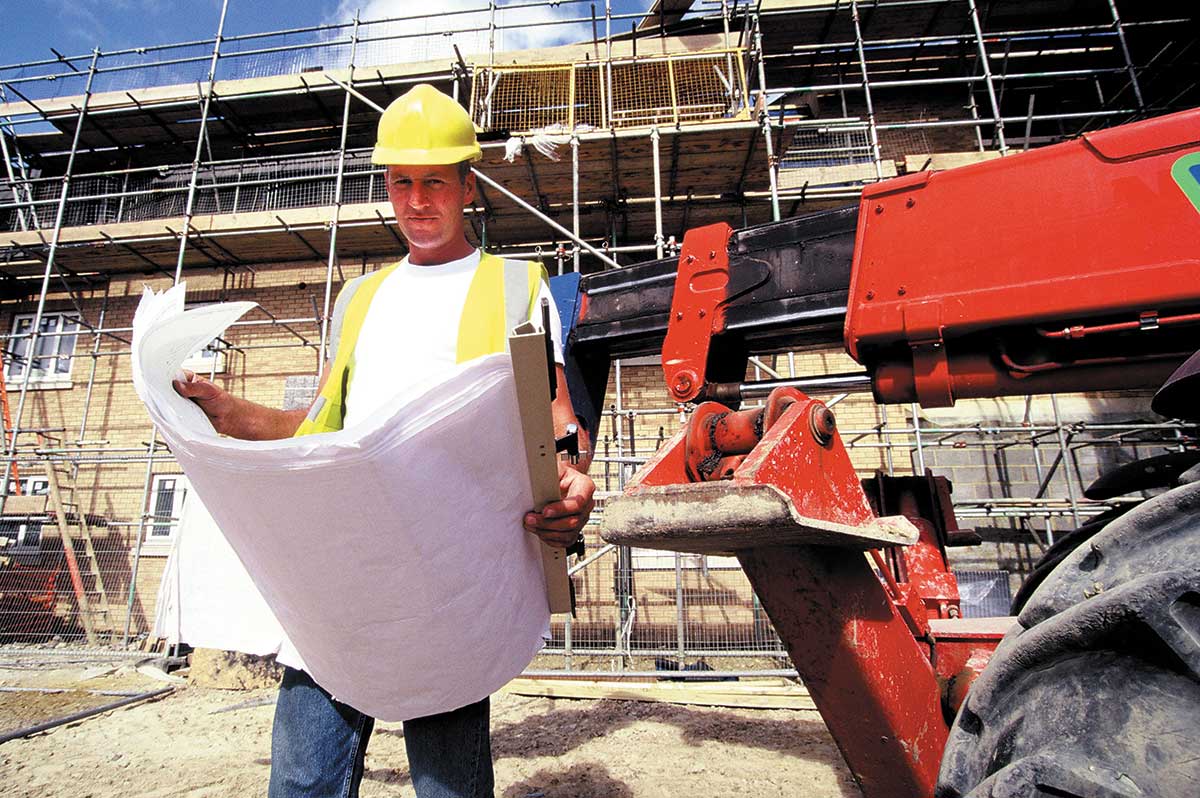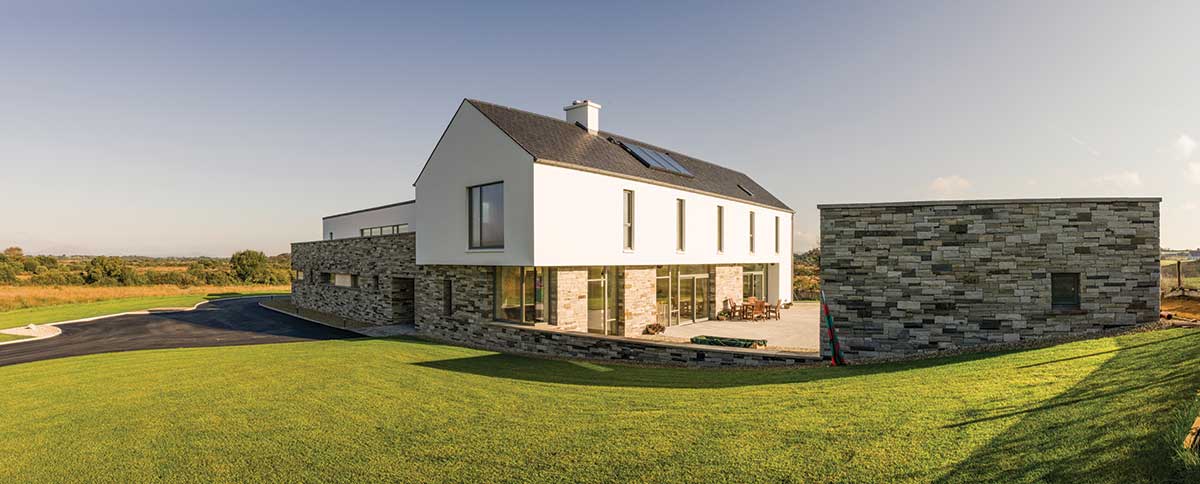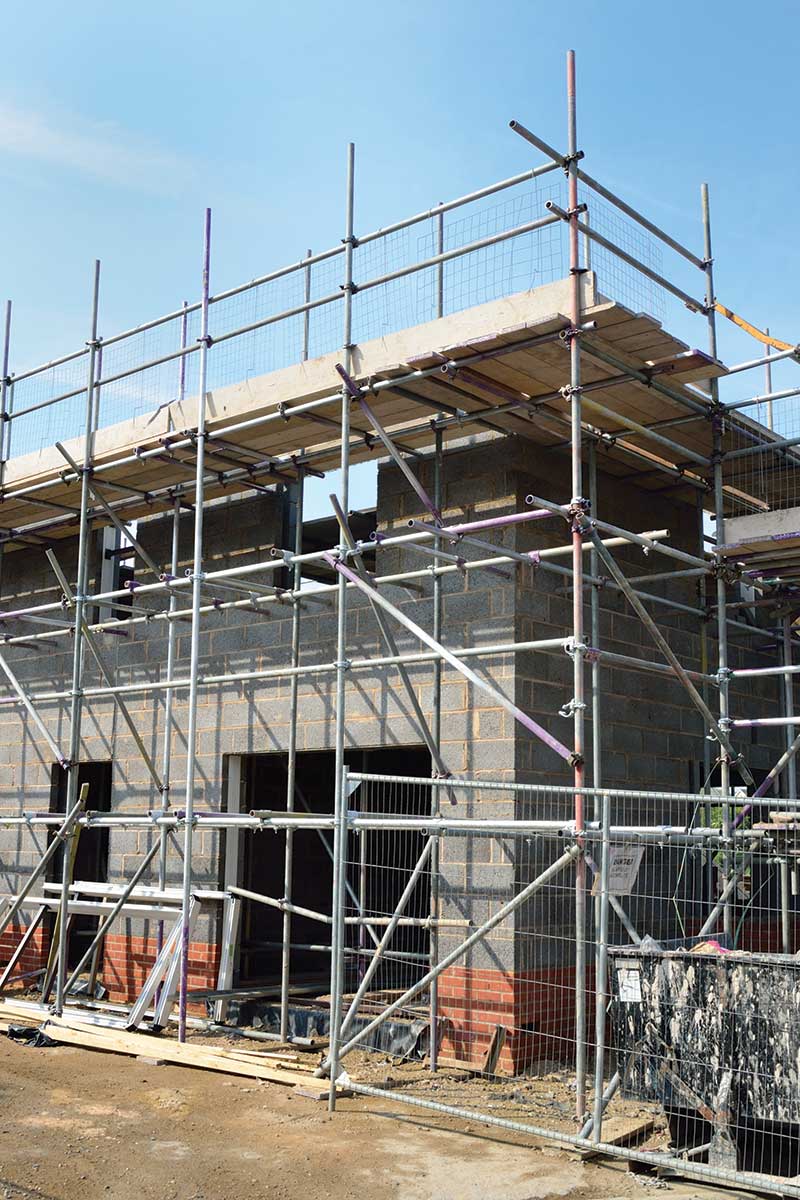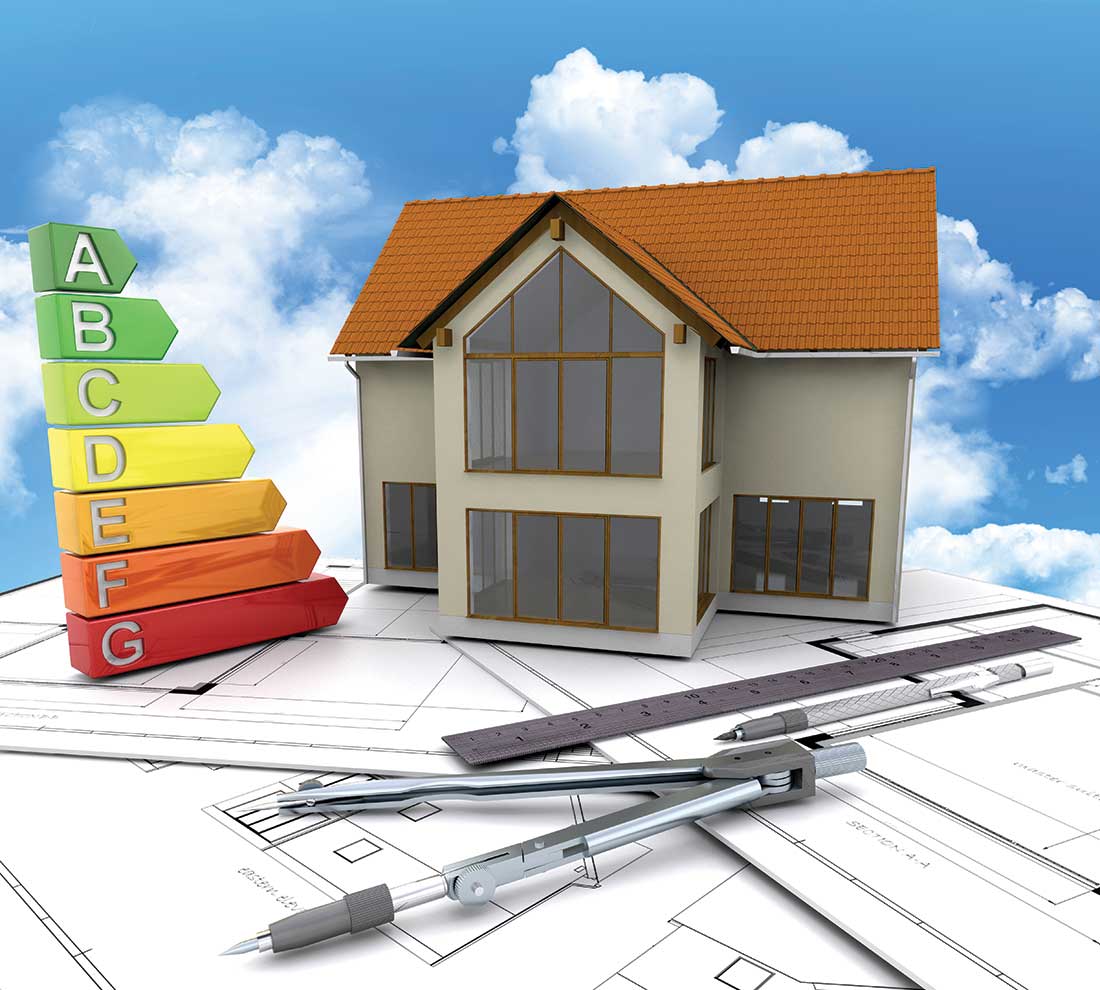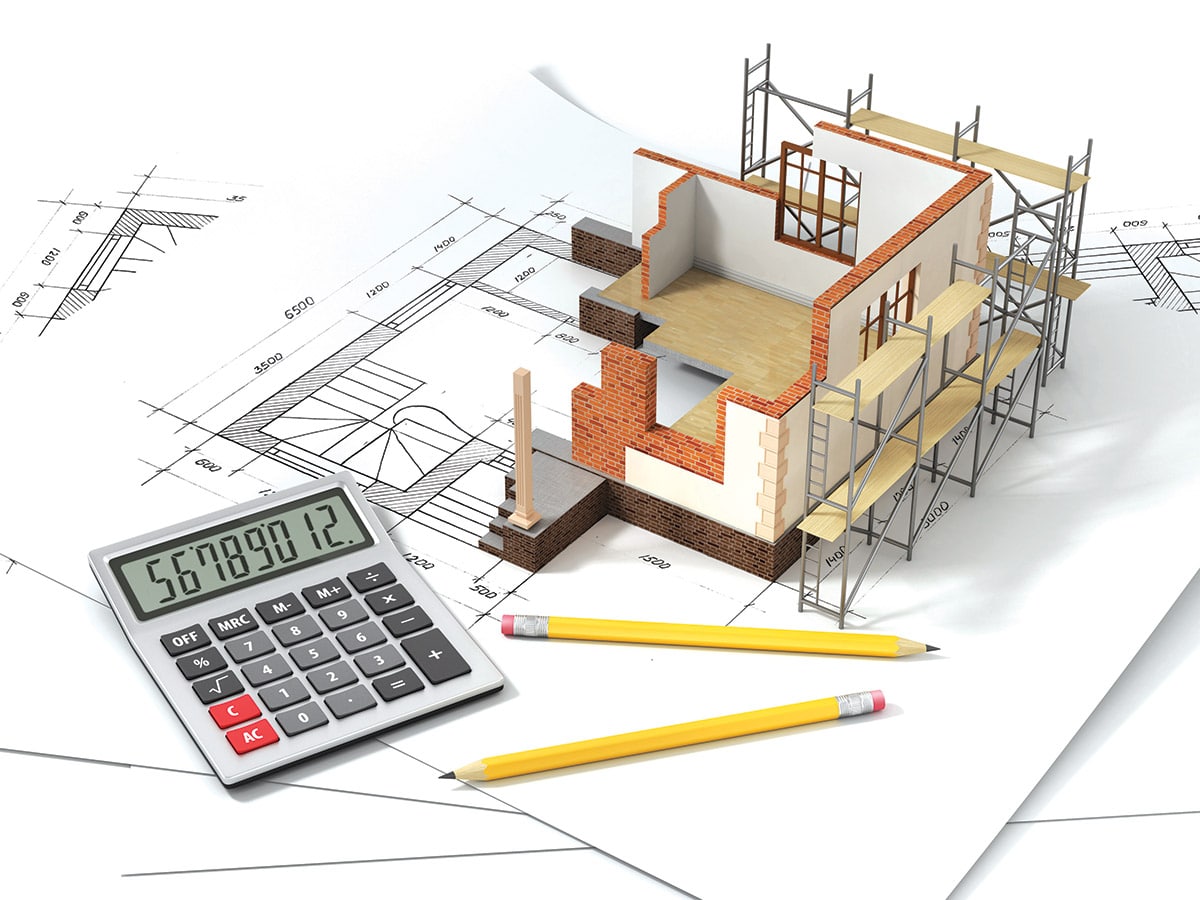Find out how to keep on top of the budget and save money with our handy step by step self-build budget guide.
In this article we cover:
- Step by step guide to budgeting with simple ways to save on the build
- Main reasons for going overbudget
- Getting the money
- Main cost components of a self-build project
- Quantity surveyors: their role and how they can help you save money
- Build costs and how you’ll build
- Managing cash flow
- Contingencies
- Keeping financial records
- Capital gains tax and value added tax
When you set out to build yourself a home, the last thing on your mind is accounting. But keeping a watchful eye on the finances can make the difference between having a good experience and ending up with a nightmare.
Deciding what you want and what you need
Start off by deciding what it is you really need from your new build. Begin with the ‘must haves’ and then add the ‘wish list’. Bounce this around the family so all your ‘stakeholders’ feel involved, but don’t commit yourself until the financial plan is in place. Next, sit down with your partner and work out your personal finances. How much money do you actually have? How much can you borrow against your income? What are your savings? What, realistically, will your current home, if you have one, sell for?
Lots of homework should follow this conversation. Get the house valued by three agents; start talking to lending institutions; meet with your bank manager and discuss your plans; talk to your accountant if you have one; make a realistic (and preferably, pessimistic) assessment of what your savings could be worth in the future, and so on.
At this early stage we tend to fool ourselves that we’ll have more cash available than in fact is the case. It is here that money trouble starts. Be brutally honest with all the sums you come up with and, if anything, underestimate your income and borrowing power.
Decide what you’re going to do
Starting out starry eyed over a dream house you don’t have the budget to fund causes many couples I’ve known to come to grief. In my experience, the next stage is to see a professional designer. Talk through your list of wants and needs and start to get a handle on the build costs.
A locally based person will know what builders in the area charge per square metre / what the professional costs are. This is a first, rough estimate. The result is often a wake-up call. Now is the time to get real about what you can afford. If the answer is a lot less than you thought, do you still want to proceed? I think more couples should back out at this stage than actually do. It takes courage, but it’s way too dangerous for your finances, your family and your relationship to plough on with a plan that is financially doomed from the start.
Getting the money
There are a range of institutions interested in lending for self-builds, most of whom will provide up to 75 per cent of the build cost. Some will lend towards the land, others won’t. Who will lend you what will depend on your earnings and other security you can offer. If you are self-employed or building as a sell-on, then expect many more problems raising the cash.
Be prepared before you go to see your lender with a drawing of the proposed house, details of the site (with agent’s brochure if there is one), a broad timetable of when you’ll need the money (in stages over, say, one year from build start), a copy of the planning permission if you have it, and your building cost estimate from your architect or surveyor. If you can also detail the costs listed below, they’ll be mega-impressed.
Defining Cost
It’s easy to spend a third or more of your entire budget on the site, which is a good investment because you can always add to the house later as more funds become available. The land is unlikely to fall in value but tastes in housing change.
Whilst every self-builder hopes for an economic build done in double-quick time, to a high quality, the reality is that you may achieve only one of these, possibly two, but very rarely all three.
The cost of purchasing the site with attendant legal and registration fees is just the first of a huge number of other costs:
Additional reports for example, if anyone thinks the land could be contaminated, analysis of soil samples, a topographical survey.
Fees due to your lender, accountant, designer for obtaining planning permission and designing the house, structural engineer, a project manager if you’re using one, Local Authority Planning and Building Control.
Fixed costs include structural warranties, site insurance and possibly personal cover for loss of earnings, the builder, removal and storage of furniture, buying new items, driveway and garden, garage (often omitted at the outset), contingency of 10 per cent minimum, selling your existing home.
Infrastructure charges including connection to mains water, electricity, sewerage.
Borrowing costs buying the site and bridging for rent and/or the build until you can move in.
Looking at the above you’ll see that what you pay your builder is only one of a huge number of other calls on your funds. Remember that if you make any changes during the build these will cost proportionally more; this is how many builders make their profit.
Having the responsibility for this in the hands of a professional (Quantity Surveyor) can be the difference between facing a financial crisis and having the time and energy to enjoy the ‘fun’ parts of self-building.
Now decide what you can afford. Professional help in the form of a Chartered Quantity Surveyor or purchasing a Prime Cost sum (PC) costing program is an investment that will pay dividends.
In the overall scale of things it is a very small outlay, one which is almost always recouped through the savings resulting. Your architect can offer guidance also but sometimes they can be too close to the project and it helps to use a third party.
The Role of the Quantity Surveyor
In addition to acting as your financial manager, a QS can also act as a negotiator and arbitrator on your behalf.
At the design stage they will: advise on infrastructure costs, provide a budget estimate and steer the design to keep within that, consider future operating and maintenance costs, prepare a cash flow forecast to assist with borrowing, ensure tender and quotation requests are suitably prepared to allow for comparison, negotiate with contractors and suppliers.
During construction they will keep the budget on track by: monitoring progress and sequencing of works to avoid delays, ensure any changes to the specification are fairly costed, prepare correct interim payments to contractors, labourers and suppliers, safeguard contingency sums, produce regular financial updates, manage remedial plans to minimize the effect on the budget, finalise all accounts with contractors, suppliers, maintain all records and safeguard invoices and receipts and ensure that VAT is reclaimed in full (NI only).
The QS has many other functions during the build but the ones above cover those relating to managing the budget and are very comprehensive.
Having the responsibility for this in the hands of a professional can be the difference between facing a financial crisis and having the time and energy to enjoy the ‘fun’ parts of self-building.
Saving Money
The things that will save money range from simple common sense to known financial black holes. This list below is thus wide ranging, not exclusive and some may be too great a restriction. You may be able to add a few of your own at the end!
- A level site with easy access to services (water, drainage, electricity, roadway, gas, telephone, cable).
- A building that is a simple square or rectangle on plan, external walls without internal angles (Ls or Ts), few breaks in the roof, concrete roof tiles and simple brickwork facings to external walls.
- Internally, straight stairs and minimum circulation areas, radiators, off the shelf windows, doors, kitchen and bathroom, simple lighting, no conservatory, avoid hardwood floors and expensive finishes.
- You can achieve a lot with thought and time on the internet searching for well priced finishing items in sanitary ware and kitchens for example. Getting quotes from at least three suppliers will be time well spent.
Building costs
I hate it when people ask me to give them a ballpark building cost because it’s impossible to know what they have in mind, and because everyone wants, instinctively, to take a basic sum per square metre and from that calculate a build cost.
This is too general, there are so many variations that will affect it so the more detail you can supply to the builders quoting, the better the answer. Anything omitted leaves you vulnerable to having to accept the price the builder gives on the spot.
Three or four quotes is usually plenty, ask for and check out references and then take a view, having met them all and seen their work, on which you’d rather collaborate with. Choosing a builder is an important decision and shouldn’t be based solely on price.
A highly-recommended person you can get on with and trust could be worth paying more for and should save money in the long term. Remember that the cheapest builder may well have priced low to get the work, only to make his real profits from extras you may not be able to control.
How you’ll build
There are three major ways you could build. The method you choose will affect what it costs.
- Main contractor. This is the simplest and the one most self-builders opt for. The contractor will, of course, expect to make a profit of 15 to 25 per cent normally. For this he’ll manage the build, buy materials, hire the sub-contractors etc. However, you will still spend huge amounts of time and energy communicating with your contractor as the job progresses.
- Project manager. There are many different levels of service ranging from appointing a builder and sub-contractors, and pricing, through to a turn- key finish requiring a permanent presence on site. It’s therefore very important that both parties are quite clear on the terms of engagement. A project manager shares the workload and responsibility and can save you about 10 per cent compared with a main contractor, even allowing for fees of about 10 per cent of the build budget.
- Manage the whole build yourself. There are very few who can afford to take a long time off work, are unemployed or work seasonally. It is certainly the most rewarding but, unless you’ve done it before, can be very harrowing and stressful as you will be learning on the job. In return you can expect to save about 25 per cent on what a main contractor would charge you. Of course your time doesn’t come free. Nor do your nerves and energy. Unless you are really sure you can cope, I’d suggest keeping the day job and going routes 1 or 2 – bearing in mind that both of these will still make huge demands on your time and energy.
Managing cash flow
Below are the main stages to a simple house build, each costing about the same which helps planning the cash flow. Most lenders will not release money until the stage is signed off by a professional.
- Groundworks: to include, site preparation, access road, foundations, drainage and main underground service supplies
- Ground floor walls
- Scaffolding the building, first floor walls and forming the roof structure
- Covering the roof, rainwater goods, chimneys
- Internal walls
- Plumbing and wiring, first fix
- Plastering/ screeding and 2nd fix carpentry
- 2nd fix electrics/fitting kitchen and cupboards
- 2nd fix plumbing and finishing/decorating
- Snagging and external works
Try to build as fast as you can as this minimises cash flow problems. People will be happy to wait a couple of weeks to be paid, but not a couple of months. In general, the building trade works best when accounts are settled promptly because they are carrying the financial risk.
Contrary to popular belief, builders are very often worried about money. When things are getting difficult between you, whatever the reason, try to think how you’d feel if you couldn’t be sure you’d be paid at the end of each month in your job.
Taking on a small client like you is a calculated risk; in the selection process before going to contract he’ll be ‘interviewing’ you every bit as much as you are assessing him!
Contingencies
If anyone tells you not to worry about a contingency sum, ignore them. 10 to 15 per cent of the build cost must be set aside at the start; no job I have ever known has come in at the exact predicted price (unless it was ridiculously over-priced in the first place).
No job I have ever dealt with has been built exactly as planned. Many things, some out of your control, such as the weather holding you up, can contribute to a larger spend than anticipated. Without a sum put aside, you’ll be scrabbling around at the end worrying about how to pay the builder’s final account.
Even if you think you’ll finish with cash in hand, don’t spend it until you move in.
Keeping financial records
It’s essential to monitor expenditure: there’s little point making great financial plans if you don’t keep to them. Keep a daily site diary of everything significant that happens and especially of all transactions that involve money. Never, ever, throw any piece of paper away!
Keep all delivery dockets, invoices, cheque stubs, and bank statements so you can account for every penny spent, and especially cash payments. You will need these to reclaim VAT on the build (NI only). You get only one chance to do this and if you don’t have everything correct you’ll simply lose loads of money unnecessarily.
One way of making financial control easier is to have an account with a local builder’s merchant. Not only will you get a trade discount, their monthly statement is clear and there are a lot of billing odds and ends ‘under one roof ’, so to speak. If you are computer literate, keep a spreadsheet up to date every week.
There will always be changes to your planned build and thus to the budget. The earlier these come in the project the greater the effect as other parts need changed as a result. Above all, prior to sanctioning any changes, be sure you have full, agreed, prices in writing from the parties concerned.
All this financial watchfulness is crucial to keeping in control. It’s all too easy to make small changes here and there which, at the time, appear trivial in the context of the whole budget but which come back to bite you at a later date.
VAT’s that? Value Added Tax is a tax on goods and services, paid at the time you buy or use them. VAT rates and rules are forever changing, so be sure to take advice before you actually start your build. Here’s an overview of the current state of play.
Capital Gains Tax
The first good news is that when you sell what the Revenue office likes to call your ‘principal residence’, you don’t pay Capital Gains Tax (CGT), unless it is clear that you built it as a business and didn’t live in it for a reasonable length of time. Just how long this time is, is open to legal debate.
Doing several self-builds at close intervals – as some serial self-builders do – causes the Revenue to, reasonably, assume you have become a ‘trader’ and tax you accordingly. The only other situation where you might be liable is if you use part of the new house for a home office, and claim tax allowances against this part while living there.
This is perfectly legal, but when you come to sell you’ll have to pay CGT on that proportion of the house you used as an office and for which you claimed tax allowances. It can be sensible not to declare a proportion of your home as your workplace (and therefore not to make use of any allowances) so that when you come to sell, the whole value of your home remains untaxed if it is your principal residence.
If you are intending to stay in your home for many years, then making the most of your tax allowances makes sense.
VAT in the Republic
Sites In the case of sites and one off housing, the VAT treatment is dependent on whether or not the site is developed, and whether or not it is supplied for consideration in the course of business. When you buy land to build on, the vendor cannot charge you VAT unless the site is a “developed” or serviced one.
If it does have services added, such as electricity, sewerage, access road, fencing, and so on, the vendor can charge you VAT but you cannot, as a private person, reclaim it. For example, if a farmer sells you an undeveloped site, the sale of the site is not liable to VAT. If a developer sells you a developed site, the sale of the site is liable to VAT.
Serviced sites can be attractive because a lot of the infrastructure work has been done by someone else, but bear in mind that the added VAT will mean this all comes at a price.
You’ll have to take a view on what this means to you.
The House It isn’t possible to claim back any of the 13.5 per cent VAT you have paid when building your own home or having it built for you by a main Contractor. This Contractor should employ all of his own professionals and tradesmen. If he sub-contracts, you may end up paying more because the individual trader will also add his profit margin (along with accompanying VAT).
If you use direct labour and act as a project manager, you pay VAT for labour provided by VAT-registered tradesmen, at 13.5 per cent. Building materials, with the exception of readyto-pour concrete and concrete blocks (to which the 13.5 per cent rate applies), are all charged at 23 per cent. You cannot claim any of this back.
If you were to build the entire property yourself, you still can’t claim any VAT back on your materials. Specifically, there is no provision for the repayment of any excess of VAT charged at 23 per cent on building materials over the 13.5 per cent which would be chargeable if the work had been done by a VAT-registered Contractor.
The entitlement to reclaim VAT on the purchase of the site or on the house building is conditional on the intended use of the property. If you, as a private person, purchase a property or site for your own use as a private dwelling, you will not be entitled to reclaim VAT.
However, if you purchase the site or build the property with the intention of selling it on, an entitlement to VAT refunds will arise but you will also be liable to VAT on the full selling price.
Partly constructed houses If a builder/ developer sells you a partially constructed house, the sale is usually liable to VAT because the builder is selling it for business purposes.
However, if a private individual was self-building a house and could not afford to finish it, and sells it on to you, this is not normally liable to VAT Where the subject of VAT becomes of interest to self-builders in a jurisdiction that doesn’t allow any reclaims of VAT, is the amount that is payable in the first place.
Certain items when installed into a new house qualify for the 13.5 per cent rate of VAT once they have been permanently installed as fixtures. Others, classified as fittings, are subject to VAT at 23 per cent. To qualify, a ‘fitting’ must be able to be taken from a building without causing substantial damage during removal.
These rules also apply to the importation of materials for building, for example a log house. Here are a few examples of each.
‘Fixtures’ on which you pay VAT at 13.5 per cent
- Air conditioning
- Attic insulation
- Attic ladders
- Baths
- Built-in kitchen units
- Built-in wardrobes and presses
- Burglar alarms
- Central heating systems
- Double glazing
- Electrical wring
- Fencing posts
- Fires escapes
- Fireplaces
- Floor coverings stuck down to the floor
- Gates
- Insulation in cavity walls
- Immersion heaters
- PABX telephone systems
- Sewage treatment plants
- Storage heaters/radiators
- Storage tanks for oil/water
- Wooden floors
‘Fittings’ on which you pay VAT at 23 per cent
- Blinds
- Curtains
- Stand-alone electric and gas fires
- Fitted carpet and lino
- Kitchen cookers
- Lighting (other than recessed lighting)
- Mirrors
- Shelving
- Refrigerators/deep freezers
- Washing machines/dishwashers etc
- ‘Floating’ wooden flooring
If you are registered for VAT and intend using part of your home for your business, for example as an office, craftwork room, for storing tools etc. you may be able to claim VAT back on that part, but, as I mentioned above, you’ll have to pay CGT when you come to sell.
Almost all self-builders will be offered services for less money if they pay cash and thus save themselves VAT.
This is, of course, illegal as it encourages tradesmen to avoid paying income tax that is due to the Revenue. Strictly speaking this tax avoidance is the legal responsibility of the tradesman, but it is still sensible to avoid in case you too become implicated.
VAT in Northern Ireland
The rules regarding VAT in Northern Ireland are very different to those in the Republic as NI is covered by the same legislation as the rest of the UK. Before I go into the details, a few words of caution.
- Be sure to keep on the side of the Law throughout. Never pay cash without proper receipts for VAT made out to you. Ideally, never pay cash at all. Keep a very clear paper trail of all your expenditures on the build with credit/debit card statements and cheque book stubs that agree with bank statements.
- Builders working on new buildings should be zero-rated to begin so they shouldn’t charge you VAT on their services. Check your builder’s credentials and that his VAT Registration number is real and up to date. You can do this by taking his name, trading details, address and VAT number and checking the details online.
- Keep detailed records of everything you spend.
- Talk to your accountant about your intentions well before you start the planning and design stages.
- Make sure you are charged the correct amount of VAT as your claim will be invalid if it is not.
- Get hold of the application form (VAT431B in the case of a new build, VAT431C in the case of a conversion) and VAT Notice 708 so you can see what’s needed from Day One.
- Beware when building on to, or re-furbishing, listed buildings. Take advice before you start as there is a VAT tax incentive to alter a Listed building but not to keep it in good repair. As lots of period building work involves ‘repair’ it’s best to get this proportion clarified at the outset.
In essence, the good news is that on completion of your project you, as a self-builder, will be able to reclaim most of the VAT paid on materials purchased for your construction. As this can be as much as 5 to 20 per cent of the total build cost it’s quite a few thousand pounds.
You must make your claim within the appointed time and in the correct way, forward planning is therefore vital. This is one area of your project that cannot be fudged later.
Records and receipts
Rule one: keep every receipt for absolutely everything – even if it has nothing to do with VAT.
Every paid invoice will save you money in the end. Keep all credit notes, bills, invoices, a copy of the planning permission and a copy of the plans of the building. It may seem unnecessary extra effort at a time when you are sorely stretched, but sit down at the end of each day and enter things in your Day Book.
For me, these have proved invaluable on countless occasions. Years later I have looked them up and found useful information about suppliers, prices, VAT etc.
It’s time well spent. Another added benefit is if you ever get into a dispute with someone your records of what was paid (or billed), by whom, to whom and when, can quickly come to your rescue!
In essence, the good news is that on completion of your project you, as a self-builder, will be able to reclaim most of the VAT paid on materials purchased for your construction.
If you were to lose your stack of receipts you’d be in serious trouble. Building sites can be messy places and it’s easy to put down a receipt only to find it wet and illegible some hours later.
VAT records
VAT is charged as an additional percentage on most building materials. This is currently 17.5 per cent. In reality VAT is a type of purchase tax. For a VAT receipt to be of any value to you (including a hand-written one paid by cash) in your future claim it must show:
- The supplier’s VAT Registration Number
- The amount of VAT that has been paid
- The quantity and nature of the goods supplied
- The price for each item
- Your name and address if the receipt has a value of more than £100
- Everything must be clearly readable, if not, ask for a better copy.
When making your claim at the end of the project, you’ll need to supply originals, not photocopies.
I suggest making copies of all receipts very soon after you get them and then keeping these separately from the originals somewhere safe. If you were to lose your stack of receipts you’d be in serious trouble. Building sites can be messy places and it’s easy to put down a receipt only to find it wet and illegible some hours later.
Are all self-builders eligible?
No. The work must be carried out in the UK (but not the Channel Islands), and the building must not have a business use.
The DIY VAT Refund Scheme is not for developers, landlords, a property that is to be rented out or a property that is built to be sold on immediately, B&B operators, residential home care operators or membership clubs and associations. If you work from home, though, you can still make a claim for that portion you’ll use as an office.
Nearly all self-builders use tradesmen or even a single Contractor for the work. This is still all allowable under the Scheme. You can also claim for the fitting out of a ‘shell’ bought from a builder or developer. But you can’t claim for work you do to complete a building that is already ‘completed’ by a developer (adding a garage, for example).
Don’t forget that this refund system applies to conversions too, that is if a building was not originally used as a dwelling (such as an old dairy), the Refund is available if it has been unoccupied or unused for ten years or more. To prove a property has been empty for a suitable length of time before you start your work you may have to contact the empty property officer at your local authority.
They will write a letter confirming the place has been unoccupied for the appropriate length of time and this will back up your VAT Claim.
Other zero and low rate cases
If a dwelling has been unoccupied for two years or more, and a builder does the work, then he may claim under the 5 per cent band for a renovation project.
Also note that some building materials installed in the home are eligible for the lower 5 per cent rate, in particular energy saving items such as heat pumps, solar panels, insulation, draught proofing, etc. Also know that if you are upgrading a bathroom for mobility purposes it will be zero rated. Builders can have different VAT ratings.
As seen in the introduction a builder creating a new house for you will not charge VAT at all on his services. If he supplies goods that are intrinsic to the house he should not charge you VAT on these either; items such as plug-in appliances and freestanding furniture will be charged at the standard rate.
What building materials can I claim for?
Put simply, those that are ‘incorporated’ into the building itself or the site. They must be fixed and be a part of the structure such that their removal would damage the site or building.
Here’s a short list of things you can claim for:
- Outside: drainage, paths, driveways, fencing, boundary walls
- Air conditioning
- Burglar alarms
- Fitted kitchen cupboards
- Indoor swimming pools
- TV aerials
- Ventilation
- Curtain poles and rails
- Windows
- Smoke alarms
- Solar panels
- Doors
- Wooden floors
- Fireplaces
- Lifts
- Wiring
- Power sockets
- Built-in vacuum systems
- Solid fuel cookers and oil-fired boilers
- Plumbing installations
- Decorating materials
- Heating systems
- Light fittings
- Turf, plants and trees (if detailed on your planning documents)
- Fitted wardrobes (if a part of the house rather than a demountable kit)
Building materials bought from any EU source qualify for the VAT refund. You have to be able to supply the details of the import and evidence that the VAT has been paid. You’ll also be required to submit the amount of your claim in Sterling.
If you import items from non-EU countries you can still claim the VAT but you have to prove you’ve paid it and also show copies of transit and shipping documents.
You cannot claim for:
- The site. There should be no VAT charged on bare building land anyway. Tell the vendor you intend to build your own place. If the site has some services there could be a small amount of VAT due but it won’t be on the whole value of the site.
- The full VAT refund on conversions. Contractors and builders can charge a reduced VAT rate of 5 per cent on conversions.
- Granny annexes that cannot be used or disposed of separate from the main house. This is because a granny annex is not ‘designed as a dwelling’ from the start.
- Detached workshops, playrooms or enclosed swimming pools; for the same reason as the above point.
- Fitted furniture.
- Garden ornaments, ponds, sheds and greenhouses.
- Carpets and other floor coverings that can be removed.
- Most electrical appliances.
- Consumables (sandpaper, paint brushes).
- Any services. For example the professional services of architects, surveyors, designers, planning consultants, project management etc. You also cannot claim for hiring or buying tools and plant, hiring services such as skips/ladders/access/ scaffolding etc.
- Extensions. This makes it vital to incorporate that conservatory at the beginning rather than waiting a year or two after you’ve completed your build. If you do, you’ll lose out on the VAT refund on the materials.
When to claim
This should be done at the completion of all the work on the project. This means finishing everything that you’ll ever want to claim on. It makes sense therefore to do as much outside work as you can at the same time as the build, even if it does stretch the budget. Get a claim pack from the Revenue or print off the forms from the website.
It can be hard to know exactly when your build is complete, but it is usually common sense once everything is done according to the original planning documents. You may also get a Certificate of Completion from Building Control.
If you are borrowing money this will be essential to get your final payment, or at the very least inform your lender that everything is complete. A letter from them or a Council Tax assessment are also acceptable to the Revenue From this completion date you now have three months to make your claim.
Send in:
- The Claim Form
- A description of the building goods and their quantities
- Other goods/materials and services claimed for
- Your claim calculations
- The VAT invoices and other documents that support your claim
- Evidence that the work has been completed
- A copy of the Planning Permission
- A copy of the plans
When making your calculations, don’t forget to allow for credits or discounts given by your suppliers; returned goods or bulk purchases. Keep a copy of everything you send just in case the Revenue needs clarification.
Your refund payment will usually come through approximately 30 days after your claim is lodged, provided the Revenue doesn’t need more information on anything.
Note: No matter which way you intend to build, always take professional advice. Also keep abreast of changes in rates and allowances.
Andrew Stanway, updated by Astrid Madsen
Additional information: Check the validity of any EU VAT number (GB for NI and IE for ROI) on the European website VAT Information Exchange System: www.ec.europa. eu/taxation_customs/vies
NI: VAT helpline number: 03000 569 145 / 0300 200 3700 Monday to Friday 9am to 4pm (lines are apparently less busy in the morning). www.gov.uk/vat-building-new-home
ROI: Revenue Property Guide www.revenue.ie If you don’t find answers here ring your local tax office to get clarification for your specific circumstances.

